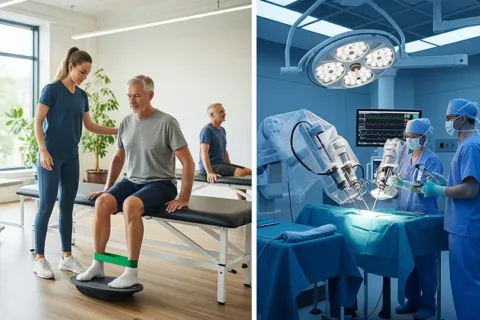Table of Contents
Quick Answer: What is Precordial Catch Syndrome?

Precordial catch syndrome (PCS) is a harmless condition causing sudden, sharp chest pain on the left side near the heart. Despite feeling intense, it resolves within seconds to minutes without treatment and poses no danger. It commonly affects children ages 6-20 and typically disappears with age.
Understanding Precordial Catch Syndrome: Why That Sharp Chest Pain Isn't Your Heart
If your child suddenly clutches their chest with a look of pain, or if you’re a young adult experiencing knife-like chest pain that takes your breath away, you might be experiencing precordial catch syndrome. Despite its alarming presentation, this condition is completely benign and more common than most people realize.
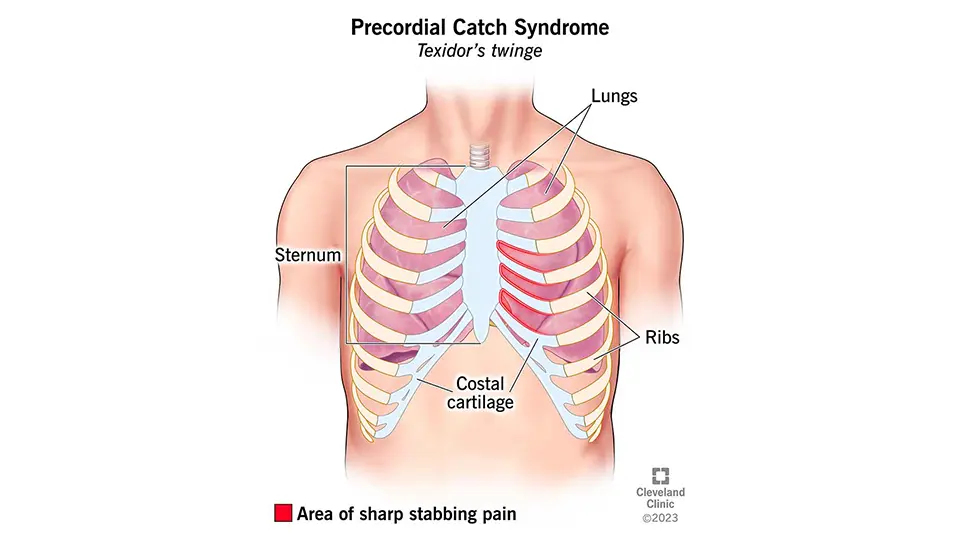
What Exactly is Precordial Catch Syndrome?
Precordial catch syndrome, also known as Texidor’s twinge, is a benign cause of chest wall pain that primarily affects children, teenagers, and young adults. The term “precordial” means “in front of the heart,” which describes exactly where the pain occurs—not in the heart itself, but in the chest wall above it.
First formally described in 1955 by doctors Miller and Texidor, precordial catch syndrome accounts for an estimated 80-90% of non-traumatic chest pain in children once cardiac causes are ruled out. Despite being so common, it remains underrecognized by both parents and healthcare providers.
Symptoms of Precordial Catch Syndrome: Recognizing the Signs
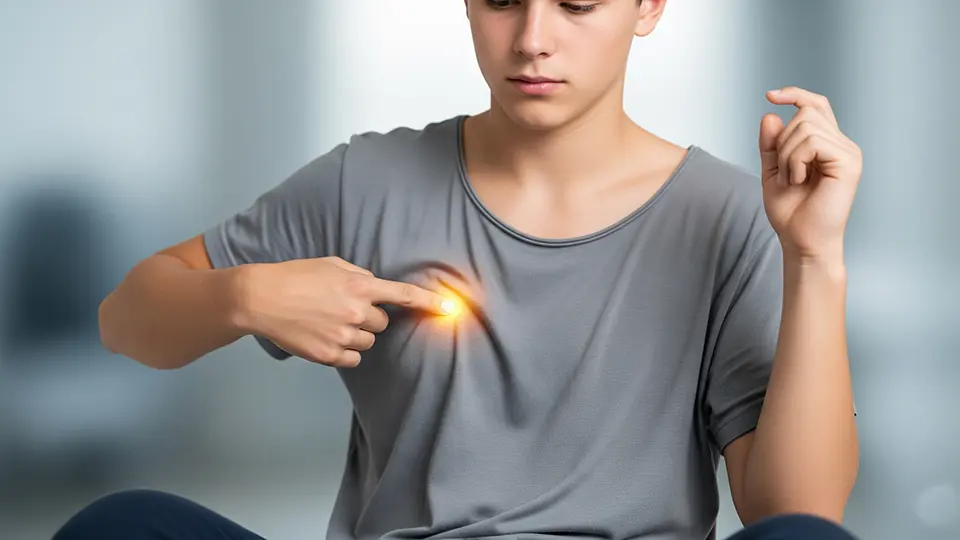
Primary Symptoms
The hallmark symptom of precordial catch syndrome is sudden, sharp, stabbing pain with these specific characteristics:
- Location: Left side of the chest, typically below the nipple
- Size: Small, localized area (can point to it with 1-2 fingers)
- Duration: 30 seconds to 3 minutes (rarely up to 30 minutes)
- Intensity: Sharp, knife-like, or needle-like sensation
- Trigger: Worsens with deep breathing
- Position: Often occurs when slouching or at rest
What You WON’T Experience
Understanding what precordial catch syndrome doesn’t cause is equally important:
- ❌ No radiation to arms, jaw, or back
- ❌ No sweating or nausea
- ❌ No fever or illness
- ❌ No heart palpitations
- ❌ No fainting
- ❌ No skin color changes
- ❌ No lasting effects after pain resolves
When Precordial Catch Syndrome Typically Occurs
The pain characteristically appears during:
- Sitting or lying down
- Poor posture (slouching)
- Sudden position changes
- Light activity (rarely during exercise)
- Times of rest or inactivity
Important: The pain never occurs during sleep and has no connection to meals or physical exertion.
What Causes Precordial Catch Syndrome?
While the exact mechanism remains unclear, medical experts believe precordial catch syndrome results from:
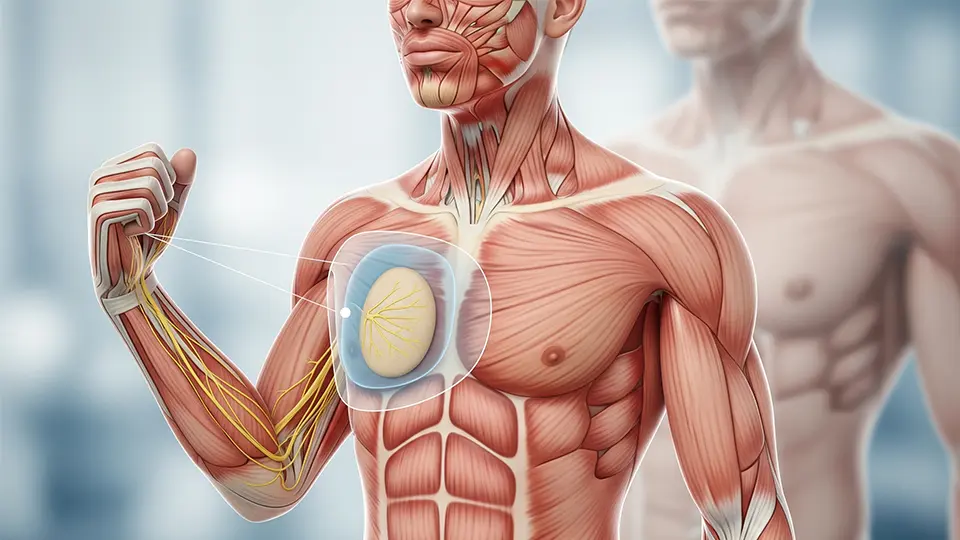
Primary Theories
- Nerve Irritation: Pinched or irritated intercostal nerves in the chest wall
- Pleural Irritation: Compression of the pleura (lung lining) during certain positions
- Muscle Spasms: Brief spasms in chest wall muscles
- Growth-Related: May coincide with growth spurts in adolescents
Risk Factors and Triggers
- Age: Most common between ages 6-20
- Posture: Poor posture, especially prolonged slouching
- Body Type: More common in thin individuals
- Growth Spurts: May increase during rapid growth periods
- Stress: Psychological stress may increase frequency
The Science Behind Precordial Catch Syndrome
Understanding the Anatomy
To truly understand precordial catch syndrome, it’s helpful to know the anatomy of the chest wall. The chest cavity is protected by the ribcage, which consists of 12 pairs of ribs connected to the spine in the back and the sternum in the front. Between each rib run the intercostal muscles and nerves, responsible for breathing movements and sensation.
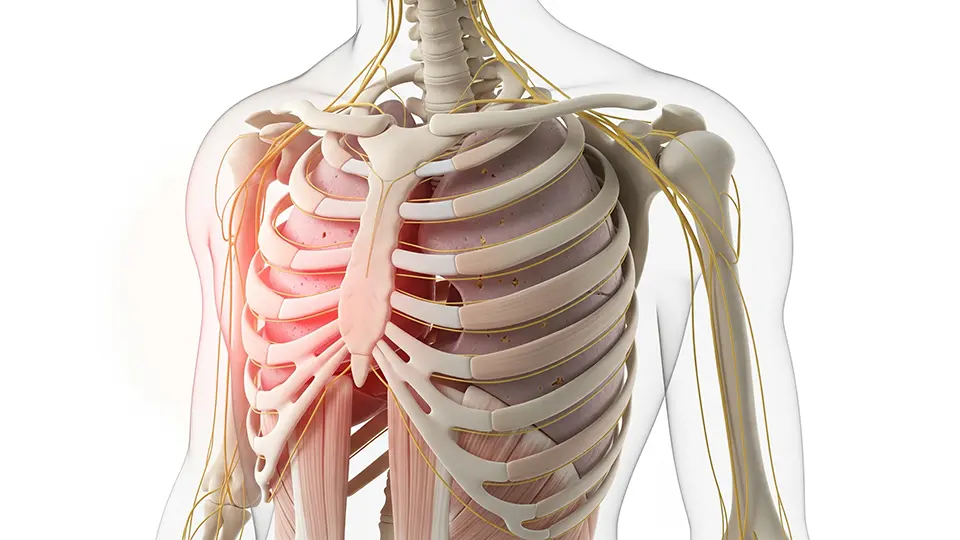
The pleura is a thin, two-layered membrane that surrounds the lungs. The inner layer (visceral pleura) covers the lungs directly, while the outer layer (parietal pleura) lines the chest wall. Between these layers is a small amount of fluid that allows smooth movement during breathing. When you experience that sharp chest pain left side characteristic of precordial catch syndrome, it’s believed to originate from irritation in these structures—not from the heart itself.
The intercostal nerves, which run along the bottom of each rib, can become temporarily pinched or irritated, especially when we slouch or maintain poor posture. This explains why chest pain when breathing in becomes more intense—the expansion of the chest during inhalation stretches these already irritated nerves.
The Physiological Process
When precordial catch syndrome occurs, several things happen in rapid succession:
- Initial trigger: Usually positional, causing nerve compression
- Pain signal: Sharp, localized pain message sent to the brain
- Protective response: Shallow breathing to avoid pain
- Resolution: Nerve releases, pain stops abruptly
This process explains why the chest pain goes away quickly—once the nerve is no longer compressed or irritated, the pain signal immediately stops, unlike muscular pain which might linger.
Precordial Catch Syndrome vs. Heart Problems: Key Differences
Understanding the differences between precordial catch syndrome and cardiac chest pain is crucial for peace of mind:
| Feature | Precordial Catch Syndrome | Cardiac Chest Pain |
|---|---|---|
| Duration | Seconds to 3 minutes | Usually >10 minutes |
| Location | Small, specific spot | Diffuse, central chest |
| Character | Sharp, stabbing | Pressure, squeezing |
| Breathing | Worse with deep breaths | No change with breathing |
| Activity | Occurs at rest | Often with exertion |
| Associated Symptoms | None | Sweating, nausea, fatigue |
| Resolution | Sudden, complete | Gradual or with treatment |
Diagnosis: How Doctors Identify Precordial Catch Syndrome

Clinical Diagnosis
Precordial catch syndrome is diagnosed based on:
- Characteristic History: The specific pattern of pain described above
- Normal Physical Exam: No abnormal heart sounds or chest tenderness
- Absence of Red Flags: No concerning symptoms requiring further testing
When Tests Might Be Ordered
While precordial catch syndrome doesn’t require testing, doctors may order tests if:
- Symptoms are atypical
- Family history of heart disease exists
- Pain persists longer than typical
- Other concerning symptoms present
Remember: Precordial catch syndrome is NOT a diagnosis of exclusion—experienced providers can diagnose it confidently based on history alone.
Treatment and Management of Precordial Catch Syndrome

Immediate Relief Techniques
When precordial catch syndrome pain strikes:
- Deep Breathing Method
- Take one slow, deep breath despite the pain
- Hold for 2-3 seconds
- This often “breaks” the pain cycle
- Posture Correction
- Straighten your back
- Roll shoulders back
- Lift chest upward
- Gentle Stretching
- Raise the affected arm overhead
- Gentle side bend away from pain
- Hold for 10-15 seconds
Long-Term Management
Since precordial catch syndrome is benign and self-limiting:
- No medication needed: Pain resolves before medicine would work
- Education is key: Understanding the condition reduces anxiety
- Posture improvement: Better posture may reduce frequency
- Reassurance: Knowing it’s harmless helps manage episodes
What NOT to Do
- ❌ Don’t panic or rush to the emergency room
- ❌ Don’t restrict physical activity
- ❌ Don’t undergo unnecessary cardiac testing
- ❌ Don’t take daily preventive medications
Living with Precordial Catch Syndrome: Practical Advice

For Parents
- Stay calm: Your reaction influences your child’s anxiety
- Educate: Explain it’s not dangerous using age-appropriate language
- Document: Keep a diary of episodes to identify patterns
- Communicate: Inform teachers and caregivers about the condition
For Young Adults
- Recognize triggers: Notice if poor posture precedes episodes
- Practice breathing: Learn the deep-breathing technique for quick relief
- Reduce anxiety: Remember each episode will pass quickly
- Maintain normal activities: Don’t let fear limit your life
School and Sports Considerations
Precordial catch syndrome should not:
- Exclude children from physical education
- Require special accommodations
- Limit sports participation
- Need emergency action plans
When to Seek Medical Attention

While precordial catch syndrome is harmless, seek medical evaluation if:
Red Flags Requiring Immediate Attention
- Pain lasting >30 minutes continuously
- Pain with exercise or exertion
- Associated dizziness or fainting
- Difficulty breathing beyond the pain
- Fever or signs of illness
- Pain radiating to other areas
Schedule a Doctor’s Visit If:
- Episodes become more frequent
- Pattern of pain changes
- Anxiety about symptoms increases
- You need reassurance about the diagnosis
Prognosis: What to Expect Long-Term

The outlook for precordial catch syndrome is excellent:
- Natural Resolution: Most people outgrow it by their early 20s
- No Complications: Never progresses to serious conditions
- No Long-term Effects: Leaves no lasting damage
- Decreasing Frequency: Episodes typically become less frequent over time
Age-Related Patterns
- Childhood (6-12): May occur several times per week
- Adolescence (13-18): Peak frequency, then gradual decrease
- Young Adulthood (19-25): Sporadic episodes
- Adulthood (25+): Rare or complete resolution
Frequently Asked Questions About Precordial Catch Syndrome
Can precordial catch syndrome be prevented?
While not entirely preventable, maintaining good posture and staying active may reduce frequency.
Is precordial catch syndrome hereditary?
There’s no evidence of genetic inheritance, though multiple family members may experience it coincidentally.
Can adults develop precordial catch syndrome?
While most common in youth, adults can experience it, though new onset in adulthood is rare.
Does stress cause precordial catch syndrome?
Stress doesn’t directly cause it but may increase awareness of episodes or frequency in some individuals.
Should I avoid exercise with precordial catch syndrome?
No, regular physical activity is encouraged and doesn’t worsen the condition.
Expert Tips for Managing Precordial Catch Syndrome
- Create a “Pain Plan”: Write down what to do during episodes for quick reference
- Use Distraction: Engage in calming activities when pain occurs
- Practice Good Posture: Set reminders to check posture throughout the day
- Build Confidence: Each resolved episode reinforces that it’s harmless
- Educate Others: Share information with family and friends to reduce concern
Need Professional Reassurance? Consult with Our Expert Physiotherapists
While precordial catch syndrome is harmless, we understand that chest pain can be concerning. Our experienced physiotherapists specialize in:
✅ Comprehensive chest wall assessments to rule out musculoskeletal issues
✅ Posture analysis and correction to reduce PCS episodes
✅ Breathing technique training for pain management
✅ Youth sports physicals and injury prevention
✅ Parent education on managing childhood chest pain concerns
Don’t let worry about chest pain affect your child’s quality of life. Our pediatric physiotherapy team can provide the assessment, education, and peace of mind your family needs.
📞 Book Your Assessment Today
🔹 Same-week appointments available
🔹 Direct billing to most insurance providers
🔹 Telehealth consultations available
The Bottom Line on Precordial Catch Syndrome
Precordial catch syndrome, while momentarily painful and frightening, is a completely benign condition that requires no treatment beyond reassurance and education. Understanding its characteristic features—sudden sharp pain, brief duration, and complete resolution—helps distinguish it from serious conditions and reduces anxiety for both patients and families.
Remember: If your or your child’s symptoms match the classic presentation of precordial catch syndrome, you can be confident that this uncomfortable but harmless condition will resolve on its own and likely disappear entirely with age.
Medical Disclaimer: This article is for educational purposes only and should not replace professional medical advice. If you’re experiencing chest pain, especially if it’s new, severe, or accompanied by other symptoms, seek immediate medical evaluation to rule out serious conditions.

